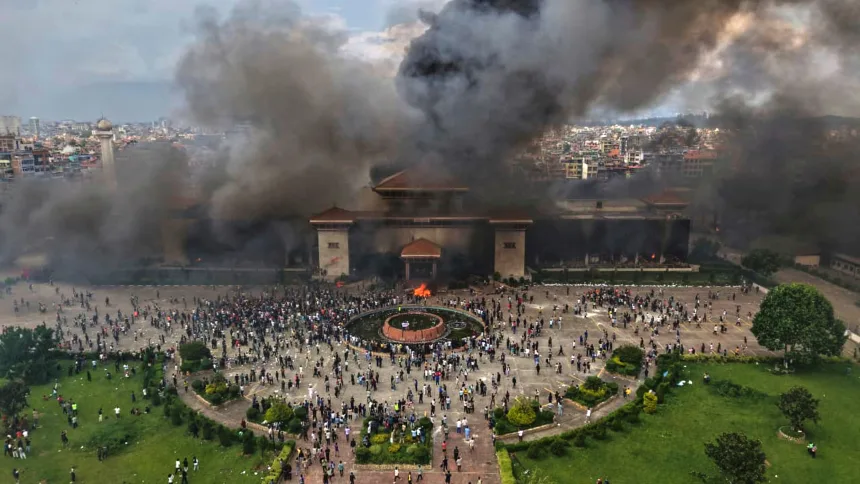Nepal is witnessing one of its most intense uprisings in recent years, led predominantly by Generation Z activists demanding political reform, transparency, and an end to entrenched corruption. What began as a peaceful protest opposing a government-imposed ban on social media platforms rapidly escalated into violent clashes, resulting in at least 34 deaths and over a thousand injured, shaking the nation to its core.
Origins and Escalation of the Nepal Gen Z Protests
The Nepal gen z protests erupted following a government order issued on September 4, 2025, shutting down 26 popular social media platforms including Facebook, X (formerly Twitter), YouTube, Snapchat, and others. This move was part of regulatory demands but ignited widespread fury, particularly among Nepal’s youth, who rely heavily on these platforms for communication and expression. The ban became the “final straw” amid harassment scandals, rampant unemployment, rising inequality, and blatant political corruption, especially highlighting the undue privileges of political elites and their families.
Tens of thousands, largely composed of young demonstrators from the Gen Z demographic (ages approx. 13-28), gathered initially in Kathmandu’s Maitighar Mandala and other key locations. The protests quickly grew, with demonstrators attempting to breach the Federal Parliament building, prompting a harsh security crackdown that involved tear gas, rubber bullets, water cannons, and live ammunition. The violence left at least 34 dead and hundreds injured, sparking national and international condemnation.
Political Fallout and Calls for Reform
In the face of escalating unrest, Nepal’s Prime Minister K.P. Sharma Oli resigned on September 9, 2025, acknowledging the “extraordinary situation.” However, the resignation has not quelled the demands of protestors who are pushing for deeper systemic changes. The youth activists advocate for the dissolution of the current Parliament and the formation of an interim government. They also call for necessary amendments to the Constitution to better reflect the will of the people but assert that the Constitution itself should not be dismantled.
The Gen Z movement, characterized by its leaderless and decentralized nature, has proposed former Chief Justice Sushila Karki—the country’s first female chief justice—as the interim leader tasked with guiding Nepal through this political transition. Talks involving Gen Z representatives, the President Ramchandra Paudel, and Army Chief Ashok Raj Sigdel are ongoing at the army headquarters in Bhadrakali to facilitate this transition and restore order.
Gen Z spokesperson Ojaswi Raj Thapa emphasized, “Right now, we need an interim government, for which we have proposed the name of Sushila Karki… We want to dissolve the current Parliament and maintain law and order in the country.” Despite the unrest, the movement stresses its commitment to peaceful, lawful action, seeking transformation without discarding Nepal’s democratic framework.
Security and Humanitarian Concerns
As protests engulfed the nation, the Nepali Army was deployed across Kathmandu to restore peace and enforce curfews, particularly near government buildings. The unrest also caused chaos at the district jail in Rajbiraj, where 192 prisoners attempted an escape; many were apprehended by security forces and border personnel. Shops, schools, and essential services remain largely closed, contributing to a tense and uncertain atmosphere.
On the international front, the Government of India and various Indian state governments have been actively coordinating the safe evacuation of their citizens stranded in Nepal. Special flights arranged by Air India and efforts from states like Andhra Pradesh and Chhattisgarh have helped bring hundreds of Indian nationals safely home amidst the crisis. Indian politicians, including NCP’s Supriya Sule and BJP’s Anurag Thakur, have expressed concern and urged for peaceful resolution citing close India-Nepal ties.
Impact and Future Outlook
Nepal Gen Z protests have exposed deep-rooted dissatisfaction among the country’s youth over political corruption, lack of employment opportunities, and inadequate representation. Many see the movement as a historic step towards reclaiming Nepal’s democracy and addressing longstanding socio-economic issues.
Despite the Prime Minister’s resignation, the movement shows no signs of abatement, focusing now on interim governance and constitutional amendments to pave the way for credible elections within six months, as noted by Gen Z leaders. The road ahead remains uncertain but signals a powerful demand from Nepal’s youth for transparency, accountability, and change.
Summary of Key Developments
- Gen Z-led protests in Nepal erupted over social media bans and corruption, escalating into violent unrest with 34 reported deaths.
- Prime Minister K.P. Sharma Oli resigned amid political crisis, but protesters demand Parliament dissolution and constitutional reforms.
- Former Chief Justice Sushila Karki considered for interim government leadership to guide political transition.
- Nepal Army deployed to enforce curfews and restore order in Kathmandu.
- Indian government actively coordinating evacuation of citizens from Nepal amid security concerns.
- Protesters emphasize peaceful change without dismantling Nepal’s Constitution, aiming for elections within six months.
This ongoing political upheaval marks a critical juncture for Nepal, highlighting the power of youth activism and pressing need for meaningful reforms. The nation—and the world—watch as Nepal’s Gen Z aims to reshape its political landscape for generations to come.

